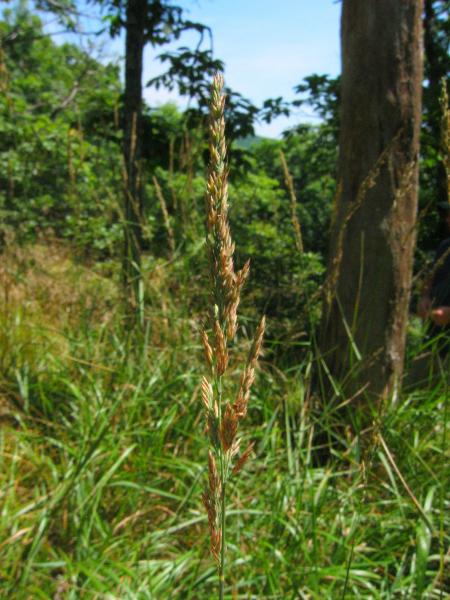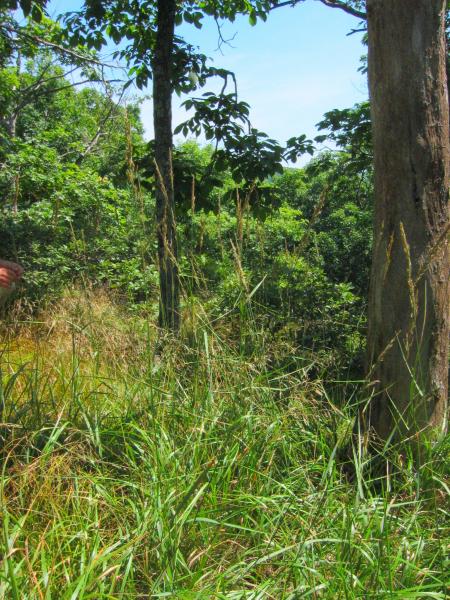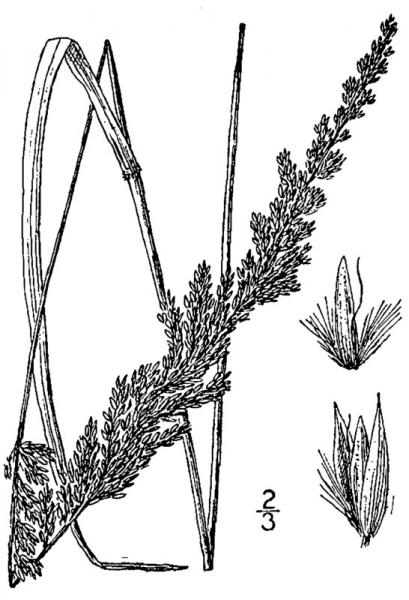Clausen's Reed Grass
Calamagrostis perplexa Scribn.
- Class
- Monocotyledoneae (Monocots)
- Family
- Poaceae (Grass Family)
- State Protection
- Endangered
Listed as Endangered by New York State: in imminent danger of extirpation in New York. For animals, taking, importation, transportation, or possession is prohibited, except under license or permit. For plants, removal or damage without the consent of the landowner is prohibited.
- Federal Protection
- Not Listed
- State Conservation Status Rank
- S1
Critically Imperiled in New York - Especially vulnerable to disappearing from New York due to extreme rarity or other factors; typically 5 or fewer populations or locations in New York, very few individuals, very restricted range, very few remaining acres (or miles of stream), and/or very steep declines.
- Global Conservation Status Rank
- G1
Critically Imperiled globally - At very high risk of extinction due to extreme rarity or other factors; typically 5 or fewer populations or locations in the world, very few individuals, very restricted range, very few remaining acres (or miles of stream), and/or very steep declines.
Summary
Did you know?
Calamagrostis perplexa is one of only a few plant species endemic to New York State, meaning that it is native only to our state and no where else in the world. However, it has recently been found near the Massachusetts border. With future fieldwork, new discoveries may compel New York botanists to share this globally rare species with our neighbors.
State Ranking Justification
The three known sites in New York are the only verified occurrences in the world.
Short-term Trends
Additional surveys are needed to determine short-term trends for this species. One of its two confirmed locations it has not been surveyed since 1992.
Long-term Trends
One site has had a population of several thousand stems (which may be one genetic individual) persist for at least 111 years. The other site was only recently discovered and so lacks long-term population trend data.
Conservation and Management
Threats
No threats are apparent.
Conservation Strategies and Management Practices
No management needs are apparent.
Research Needs
This species is suspected to be a sterile hybrid between Calamagrostis porteri and C. canadensis. Additional research is needed to confirm this.
Habitat
Habitat
Each of the known sites for Calamagrostis perplexa are on dry, rocky, west-facing ridges between 1300 and 1800 feet. The soils are rocky and somewhat acid. These sites have oak-dominated canopies with abundant openings dominated by grasses and sedges. There is fairly abundant habitat of this type in the state, and the species may have been overlooked in the past (New York Natural Heritage Program 2009).
Associated Ecological Communities
- Appalachian oak-hickory forest
(guide)
A hardwood forest that occurs on well-drained sites, usually on ridgetops, upper slopes, or south- and west-facing slopes. The soils are usually loams or sandy loams. This is a broadly defined forest community with several regional and edaphic variants. The dominant trees include red oak, white oak, and/or black oak. Mixed with the oaks, usually at lower densities, are pignut, shagbark, and/or sweet pignut hickory.
- Pitch pine-oak-heath rocky summit
(guide)
A community that occurs on warm, dry, rocky ridgetops and summits where the bedrock is non-calcareous (such as quartzite, sandstone, or schist), and the soils are more or less acidic. This community is broadly defined and includes examples that may lack pines and are dominated by scrub oak and/or heath shrubs apparently related to fire regime.
Associated Species
- Acer pensylvanicum (striped maple)
- Aralia nudicaulis (wild sarsaparilla)
- Betula papyrifera (paper birch)
- Carex argyrantha (silvery-green sedge)
- Carex lucorum (long-beaked carpet sedge)
- Carya glabra (pignut hickory)
- Castanea dentata (American chestnut)
- Corydalis sempervirens
- Dennstaedtia punctilobula (hay-scented fern)
- Deschampsia flexuosa
- Gaylussacia baccata (black huckleberry)
- Hamamelis virginiana (witch-hazel)
- Kalmia latifolia (mountain laurel)
- Pteridium aquilinum
- Quercus alba (white oak)
- Quercus ilicifolia (scrub oak, bear oak)
- Quercus montana (chestnut oak)
- Quercus rubra (northern red oak)
- Quercus velutina (black oak)
- Rhododendron prinophyllum (early azalea)
- Schizachyrium scoparium
- Vaccinium angustifolium (common lowbush blueberry)
- Vaccinium pallidum (hillside blueberry)
Range
New York State Distribution
Calamagrostis perplexa has been confirmed at only 3 locations in eastern and central New York State, in Columbia, Tompkins, and Ulster counties.
Global Distribution
Currently Calamagrostis perplexa is known globally from only 3 counties in central and eastern New York.
Identification Comments
General Description
Calamagrostis perplexa is a perennial grass which may grow up to 1.2 m tall, either in clumps or spreading by underground stems (rhizomes). Its leaves are lax, 10 to 30 cm long and 3 to 6 mm broad, minutely scabrous (rough-hairy) on both sides, slighly glaucous (whitish) above and darker green below with tufts of hairs between the leaf sheath and the blade (Greene 1980). The stems are topped by a lax or nodding panicle (the inflorescence) 10 to 18 cm long (the longer branches are 5 to 6.5 cm long). As in all grasses, the small, inconspicuous flowers occur in scaly structures called spikelets. In the genus Calamagrostis each spikelet contains only one flower. In Wood Reedgrass one of these scales (the lemma) has a stout, twisted, bent tip (an awn) 2 to 3 mm long. The spikelets are 3 to 3.5 mm long, with 2-3 mm long hairs at the callus (the base of the lemma) (Greene 1980).
Best Life Stage for Proper Identification
Mature fruit are needed for positive identification of this species.
Similar Species
Calamagrostis perplexa may have originated as a hybrid between C. canadensis and C. porteri, and possesses some characteristics of each: the dry rocky habitat, leaves glaucous above and thick, twisted awns resemble those of C. porteri, while the lax or nodding panicle, longer callus-hairs, and sometimes branching culms resemble those of C. canadensis (Gleason and Cronquist 1991).
Best Time to See
Wood Reedgrass flowers in mid-summer and the fruits persist from mid-July into the fall.
- Fruiting
The time of year you would expect to find Clausen's Reed Grass fruiting in New York.
Clausen's Reed Grass Images
Taxonomy
Clausen's Reed Grass
Calamagrostis perplexa Scribn.
- Kingdom Plantae
- Phylum Anthophyta
- Class Monocotyledoneae
(Monocots)
- Order Cyperales
- Family Poaceae (Grass Family)
- Order Cyperales
- Class Monocotyledoneae
(Monocots)
- Phylum Anthophyta
Additional Common Names
- Clausen's Reedgrass
- Wood Reed Grass
Synonyms
- Calamagrostis porteri ssp. perplexa (Scribn.) Clausen
Additional Resources
Best Identification Reference
Mitchell, Richard S. and Gordon C. Tucker. 1997. Revised Checklist of New York State Plants. Contributions to a Flora of New York State. Checklist IV. Bulletin No. 490. New York State Museum. Albany, NY. 400 pp.
Other References
Fernald, M.L. 1970. Gray's manual of botany. 8th edition. 1970 printing with corrections by R.C. Rollins [of 1950 8th edition]. D. Van Nostrand Company, New York.
Gleason, Henry A. and A. Cronquist. 1991. Manual of Vascular Plants of Northeastern United States and Adjacent Canada. The New York Botanical Garden, Bronx, New York. 910 pp.
Greene, C. 1980. The systematics of Calamagrostis (Gramineae) in eastern North America [Ph.D. thesis]. Harvard Univ., Cambridge, MA.
Hitchcock, A.S. 1951. Manual of the grasses of the United States. 2nd edition revised by Agnes Chase. [Reprinted, 1971, in 2 vols., by Dover Publications, Incorporated, New York.]
Holmgren, Noel. 1998. The Illustrated Companion to Gleason and Cronquist's Manual. Illustrations of the Vascular Plants of Northeastern United States and Adjacent Canada. The New York Botanical Garden, Bronx, New York.
New York Natural Heritage Program. 2010. Biotics database. New York Natural Heritage Program. New York State Department of Environmental Conservation. Albany, NY.
New York Natural Heritage Program. 2024. New York Natural Heritage Program Databases. Albany, NY.
Reschke, Carol. 1990. Ecological communities of New York State. New York Natural Heritage Program, New York State Department of Environmental Conservation. Latham, NY. 96 pp. plus xi.
Weldy, T. and D. Werier. 2010. New York flora atlas. [S.M. Landry, K.N. Campbell, and L.D. Mabe (original application development), Florida Center for Community Design and Research http://www.fccdr.usf.edu/. University of South Florida http://www.usf.edu/]. New York Flora Association http://newyork.plantatlas.usf.edu/, Albany, New York
Weldy, Troy W. and David Werier. 2009. New York Flora Atlas. [S.M. Landry and K.N. Campbell (original application development), Florida Center for Community Design and Research. University of South Florida]. New York Flora Association, Albany, NY. Available on the web at (http://www.newyork.plantatlas.usf.edu/).
Links
About This Guide
Information for this guide was last updated on: March 9, 2009
Please cite this page as:
New York Natural Heritage Program. 2024.
Online Conservation Guide for
Calamagrostis perplexa.
Available from: https://guides.nynhp.org/wood-reed-grass/.
Accessed July 26, 2024.


